The Intel Core i9-9980XE CPU Review: Refresh Until it Hertz
by Ian Cutress on November 13, 2018 9:00 AM ESTGaming: Final Fantasy XV
Upon arriving to PC earlier this, Final Fantasy XV: Windows Edition was given a graphical overhaul as it was ported over from console, fruits of their successful partnership with NVIDIA, with hardly any hint of the troubles during Final Fantasy XV's original production and development.
In preparation for the launch, Square Enix opted to release a standalone benchmark that they have since updated. Using the Final Fantasy XV standalone benchmark gives us a lengthy standardized sequence to record, although it should be noted that its heavy use of NVIDIA technology means that the Maximum setting has problems - it renders items off screen. To get around this, we use the standard preset which does not have these issues.
Square Enix has patched the benchmark with custom graphics settings and bugfixes to be much more accurate in profiling in-game performance and graphical options. For our testing, we run the standard benchmark with a FRAPs overlay, taking a 6 minute recording of the test.
| AnandTech CPU Gaming 2019 Game List | ||||||||
| Game | Genre | Release Date | API | IGP | Low | Med | High | |
| Final Fantasy XV | JRPG | Mar 2018 |
DX11 | 720p Standard |
1080p Standard |
4K Standard |
8K Standard |
|
All of our benchmark results can also be found in our benchmark engine, Bench.
| Game | IGP | Low | Medium | High |
| Average FPS |  |
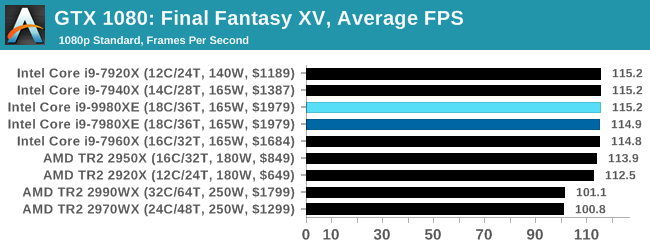 |
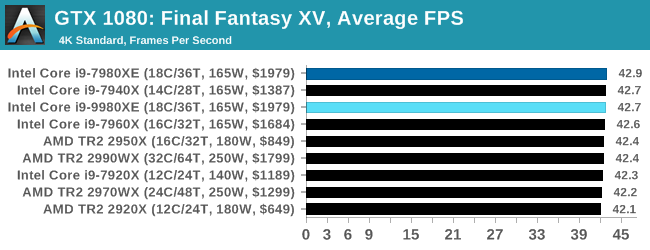 |
 |
| 95th Percentile | 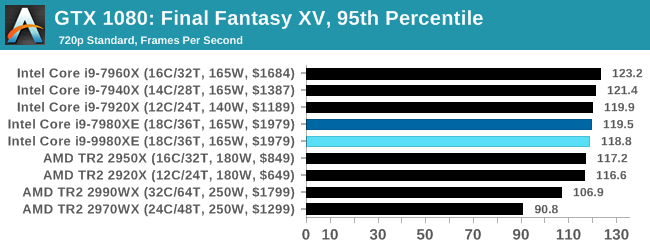 |
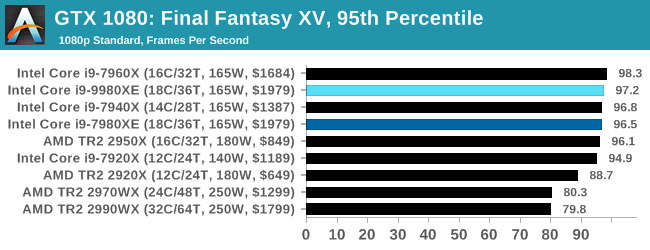 |
 |
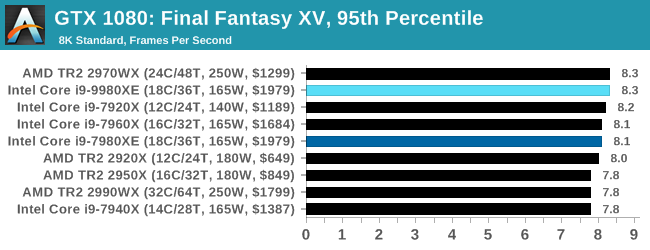 |












143 Comments
View All Comments
zeromus - Wednesday, November 14, 2018 - link
@linuxgeek, logged in for the first time in 10 years or more just to laugh with you for having cracked the case with your explanation there at the end!HStewart - Tuesday, November 13, 2018 - link
I have IBM Thinkpad 530 with NVidia Quadro - in software development unless into graphics you don't even need more than integrated - even more for average business person - unless you are serious into gaming or high end graphics you don't need highend GPU. Even gaming as long as you are not into latest games - lower end graphics will do.pandemonium - Wednesday, November 14, 2018 - link
"Even gaming as long as you are not into latest games - lower end graphics will do."This HEAVILY depends on your output resolution, as every single review for the last decade has clearly made evident.
Samus - Wednesday, November 14, 2018 - link
Don't call it an IBM Thinkpad. It's disgraceful to associate IBM with the bastardization Lenovo has done to their nameplate.imaheadcase - Tuesday, November 13, 2018 - link
Uhh yah but no one WILL do it on mobility. Makes no sense.TEAMSWITCHER - Tuesday, November 13, 2018 - link
You see .. there you are TOTALLY WRONG. Supporting the iPad is a MAJOR REQUIREMENT as specified by our customers.Augmented reality has HUGE IMPLICATIONS for our industry. Try as you may ... you can't hold up that 18 core desktop behemoth (RGB lighting does not defy gravity) to see how that new Pottery Barn sofa will look in your family room. I think what you are suffering from is a historical perspective on computing which the ACTUAL WORLD has moved away from.
scienceomatica - Tuesday, November 13, 2018 - link
@TEAMSWITCHER - I think your comments are an unbalanced result between fantasy and ideals. I think you're pretty superficially, even childishly looking at the use of technology and communicating with the objective world. Of course, a certain aspect of things can be done on a mobile device, but by its very essence it is just a mobile device, therefore, as a casual, temporary solution. It will never be able to match the raw power of "static" desktop computers.working in a laboratory for physical analysis, numerous simulations of supersymmetric breakdowns of material identities, or transposition of spatial-temporal continuum, it would be ridiculous to imagine doing on a mobile device.There are many things I would not even mention.HStewart - Tuesday, November 13, 2018 - link
For videos - as long as you AVX 2 (256bit) you are ok.SanX - Wednesday, November 14, 2018 - link
AMD needs to beat Intel with AVX to be considered seriously for scientific apps (3D particle movement test)PeachNCream - Tuesday, November 13, 2018 - link
All seven of our local development teams have long since switched from desktops to laptops. That conversion was a done deal back in the days of Windows Vista and Dell Latitude D630s and 830s. Now we live in a BYOD (bring your own device) world where the company will pay up to a certain amount (varies between $1,100 and $1,400 depending on funding from upper echelons of the corporation) and employees are free to purchase the computer hardware they want for their work. There are no desktop PCs currently and in the past four years, only one person purchased a desktop in the form of a NUC. The reality is that desktop computers are for the most part a thing of the past with a few instances remaining on the desks of home users that play video games on custom-built boxes as the primary remaining market segment. Why else would Intel swing overclocking as a feature of a HEDT chip if there was a valid business market for these things?